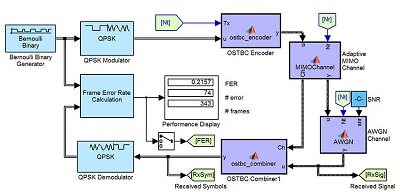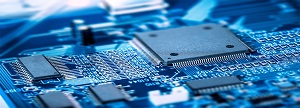Dr. Sagias has taught or is currently teaching the following undergraduate courses:
Digital Communications
Digital Communications

Undergraduate Program: Department of Informatics and Telecommunications, University of Peloponnese
Category: Specialization in Telecommunications-Core
Academic Years: 2008-today
ECTS Credits: Five (5)
Semester: Fifth (5th)
Prerequisites: Signals and Systems
Teaching: Four (4) hours lectures, one (1) hour lab (per week).
Learning outcomes: At the end of the course the student will be able to:
- Recognize the most well-known line codes and plot corresponding spectra
- Calculate the signal space dimension and design the optimal detector
- Be aware of basic digital modulation techniques with (ASK, PSK, DPSK, FSK) and without (PAM, PPM, on/off) carrier and recognize their waveforms
- Design optimum filters to eliminate intersymbol interference
- Be able to calculate bandwidth and power requirements for optimal operation of digital communication systems
- Calculate and compare the performance of basic modulation techniques in the presence of AWGN noise
Course contents: Introduction, AWGN noise, line codes and spectra, baseband modulation techniques (PAM, PPM), signal algebra, constellation diagram, Nyquist filters, correlator and matched filter, intersymbol interference, probability of error and bandwidth requirements, optimum receiver design, maximum likelihood detectors, eye pattern, carrier modulation, coherent demodulation (ASK, PSK, FSK), non-coherent demodulation (DPSK, NCFSK), performance comparison. Comparison of analog and digital signal transmission methods. For the lab of the course, the Simulink software of Matlab is used.
Assessment: Written exams at the end of the semester in both theoretical and laboratory parts with a percentage 70% and 30%, respectively. Optional midterm exams are also possible
Satellite Communications
Satellite Communications

Undergraduate Program: Department of Informatics and Telecommunications, University of Peloponnese
Category: Specialization in Telecommunications-Elective
Academic Years: 2007-today
ECTS Credits: Five (5)
Semester: Sixth (6th)
Prerequisites: -
Teaching: Three (3) hours lectures, one (1) hour lab (per week).
Learning outcomes: At the end of the course the student will be able to:
- acquire an understanding on basic concepts on satellite communications
- acquire an understanding on orbital mechanics of LEO, MEO, HEO and GEO satellites
- define and explain propagation impairments
- calculate and evaluate the characteristics of the uplink/downlink satellite link budget
- explain the analog and digital modulation techniques
- explain the synchronization and multiple-access techniques, such as FDMA, TDMA, CDMA, Aloha
- design and simulate satellite orbits with specific characteristics using STK software of AGI
Course contents: Introduction to satellite communications: Definitions, satellite types, orbital mechanics and orbits (low&medium earth orbits (LEO&MEO), high elliptical orbit (HEO), geosynchronous earth orbit (GEO)), coordinates transformations. Calculation methods for link budget, propagation impairments (free space loss, atmospheric, rain attenuation, shadowing), effects of noise on various receiver parts (antenna, absorptive network, amplifier), definitions of various parameters (EIRP, cross-polar isolation and discrimination (XPI and XPD), G/T figure, transponder input/output backoff). Description of multiple access networks and multibeam systems. Study on contemporary satellite systems (DVB-S, Iridium, GPS, Inmarsat, VSAT). Simulation studies on orbit planning and link budget with STK software by Analytical Graphics (AGI). Exercises using the STK software and analyses of link budget using spreadsheets.
Assessment: Written exams at the end of the semester. Assignments may be given during the semester with weight 30% (in which case the weight of the written exams will be 70%).
Information Theory and Coding
Information Theory and Coding

Undergraduate Program: Department of Informatics and Telecommunications, University of Peloponnese
Category: Specialization in Telecommunications-Elective
Academic Years: 2019-today
ECTS Credits: Five (5)
Semester: Sixth (6th)
Prerequisites: Probabilities and Statistics
Teaching: Three (3) hours lectures, one (1) hour tutorial (per week).
Learning outcomes: At the end of the course the student will be able to:
- explain source and channel coding necessities
- calculate the discrete and continuous messages memoryless channel
- design linear block codes with specific properties
- examine a code performance with respect to the maximum number of errors correcting
- apply decoding techniques for the transmitted message estimation
- compare different codes with respect to redundancy and performance
Course contents:Introduction, mutual information, entropy, information rate, redundancy, discrete message sources, memoryless sources, Markov sources, source coding, Hufmann coding, communication channels, discrete channel capacity, continuous channel capacity, linear block codes, Hamming coding, circular codes, systematic codes, BCH and CRC codes, burst error correcting codes.
Assessment: Written exams at the end of the semester. Given projects are optional and have 30% weight on the total course grade. Optional midterm exams are also possible.
Simulation
Simulation of Telecommunication Systems

Undergraduate Program: Department of Informatics and Telecommunications, University of Peloponnese
Category: Specialization in Telecommunications-Elective
Academic Years: 2011-today
ECTS Credits: Five (5)
Semester: Eighth (8th)
Prerequisites: Programming I OR Programming II OR Digital Communications OR Signals and Systems
Teaching: Two (2) hours lectures, two (2) hour lab (per week).
Learning outcomes: At the end of the course the student will be able to:
- generate random numbers having specific properties
- simulate the most well-known modulation formats
- design and simulate the optimum receiver
- identify the differences in system performance between theory and simulation
- evaluate the bit and symbol error probability
Course contents: Telecommunication system design by using methods and techniques based on random process, fundamental computer simulation techniques, error probability simulation, SNR simulation, Rayleigh fading, simulation code development in Matlab or Octave.
Assessment: Written exams at the end of the semester with weight 60% and compulsory assignments during the semester with weight 40%.
Design Logic
Design Logic

Undergraduate Program: Department of Informatics and Telecommunications, University of Peloponnese
Category: Core
Academic Years: 2009-2010
ECTS Credits: Six (6)
Semester: First (1st)
Prerequisites: -
Teaching: Four (4) hours lectures, two (2) hour lab (per week).
Learning outcomes: At the end of the course the student will be able to:
- describe the basic principles of binary numbers, Boolean Algebra and logic gates
- explain the basic principles of binary functions and simplify binary functions
- design and reduce combinational circuits given specific requirements
- explain the notion of memory in the context of logic circuits
- list the characteristic tables of flip-flop types D,T and JK
- read and reduce state diagrams
- design sequential circuits
Course contents: Numeral systems and codes, digital circuits, principles and practices for combinatorial logic design, basic combinatorial digital circuits, PLAs, decoders, coders, multiplexers, comparators, adders, subtractors, ALUs, principles and practices for sequential digital design, latches, flip-flops,counters, shift registers, memory.
Assessment: This is a compound course, with its total grade comprising theory (70%) and applied part (30%). Success in the applied part of the course must coincide or predate participation in the final theory exam. The applied part is graded through with laboratory exercises and written reports. Theory is graded through a written midterm exam (30%), a written examination at the end of the course (70%) and an optional semester project (40%).
Digital Systems
Digital Systems (PLI21)

Undergraduate Program: Computer Science, School of Science and Technology, Hellenic Open University
Category: Compulsory
Academic Years: 2017-2019
ECTS Credits: Twenty (20)
Semester: Third (3rd)
Prerequisites: -
Teaching: -
Module general description: Aim of this module is to introduce the students to the hardware of computer systems. Specifically, starting from the basic concepts of binary logic and logic circuits the students get familiar with the fundamental building blocks of digital systems. They also acquire the essential knowledge and skills to analyze and design both combinational and sequential circuits. These circuits are the basic components of any computer system. The architecture, structure and organization of the computer as well as of its main units (central processing unit, memory system, busses and input/output subsystem) are then considered. Finally, we deal with microprocessors, focusing on the structure and operation of two basic families of microprocessors (Intel & Motorola) and in programming using an assembly language.
Learning outcomes:
VOLUME 1: DIGITAL DESIGN
On successful completion of the study of the first volume, students will know:
- The difference between analog and digital signals.
- The advantages of digital against analog systems.
- Binary representation of numbers (BCD, sign magnitude, 1's complement, 2's complement) and the arithmetic operations between them.
- The fundamentals of error detecting and correcting codes and as examples parity based codes and the Hamming code.
- To differentiate between combinational and sequential circuits.
- To apply the axioms and theorems of boolean algebra
- Ways of representing logic functions (truth tables, logic representations) and their minimization (using theorems of Boolean algebra, Karnaugh maps).
- Correspondence of simple logic functions to logic gates and the schematic representation of logic functions with logic gates (logic circuits).
- To analyze the functionality and the design of complex logic functions which are common in digital systems (comparators, adders, decoders, multiplexers).
- To design large combinational units using as building blocks less complex logical circuits.
- To recognize and use several elementary sequential circuits (flip-flops) and their function.
- To analyze sequential circuits.
- To design sequential circuits.
- To design registers of different functionality (parallel input, shift register, multifunctional register)
- To recognize the characteristic tables of flip-flop types D,T and JK
- To reduce state diagrams
- To design sequential circuits
VOLUME 2: COMPUTER ARCHITECTURE
On successful completion of the study of the second volume, students will know:
- The units of a computer system and their operation.
- The meaning of architecture, structure, organization and implementation of a computer system.
- Methods for performance evaluation.
- The representation of information.
- The encoding of the machine language instructions and the memory addressing modes.
- Central processing unit (CPU) subunits (register file, shifters, arithmetic/logic unit, multiplier, divider) structure, organization and function.
- Memory units which are used for the implementation of the memory system and their features.
- Memory hierarchy.
- Cache memory (fetch policies, organization, placement and replacement policies and policies for updating higher levels of the memory hierarchy).
- Main memory organization and features (size, word length, bandwidth).
- Busses and their classification (dedicated, shared, CPU
- Memory busses, system busses, input/output busses, synchronous and asynchronous busses).
- Arbitration
- Input/output organization (programmed Input/Output, interrupts, direct memory access)
VOLUME 3: MICROPROCESSORS
On successful completion of the study of the third volume, students will know:
- The meaning of microprocessor, microcomputer and microcontroller.
- The evolution of the microprocessors.
- Features of several commercial microprocessors.
- Interfacing peripherals and main memory to microprocessors.
- Programming in assembly language.
Course contents: Numeral systems and codes, digital circuits, principles and practices for combinatorial logic design, basic combinatorial digital circuits, PLAs, decoders, coders, multiplexers, comparators, adders, subtractors, ALUs, principles and practices for sequential digital design, latches, flipflops,counters, shift registers, memory, computer system, architecture, arithmetic/logic unit, multiplier, divider, memory addressing, central processing unit, Memory, cache, microprocessor, assembly language.
Assessment: Completion of four written assignments during the academic year, the average grade of which constitute a 30 percent of each student's grade, if a pass is obtained in the final or repetitive examination. Final exam grades constitute a 70 percent of the students' final course grade.